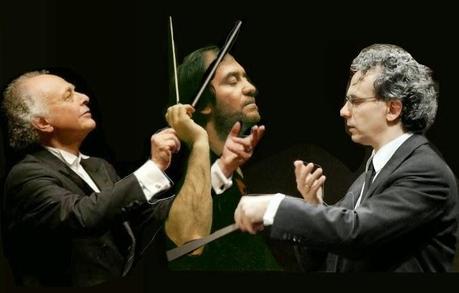by Paul J. Pelkonen

When Lorin Maazel (left) dropped out of a planned pair of April concerts,
two substitutes (Valery Gergiev and Fabio Luisi) were brought in.
This image was the result and it's my favorite photoshop I did this year.. Photo alteration by the author.
The Vienna Philharmonic at Carnegie Hall "The appearance by the Grim Reaper paved the way for the somber slow movement, a lengthy set of variations that Mahler uses to explore every musical possibility within its principal theme. Here, Mr. Eschenbach slowed down once more, taking a leisurely tour through the winding paths of cellos and bass clarinet and stopping occasionally to lead two stupendous emotional climaxes.
The Seattle Symphony at Spring For Music "Although the opening five minutes of Become Ocean recalled the first pages of Wagner's Das Rheingold before the entry of the cellos and the singers, this performance revealed hidden depths and colors in the composer's sonic tidal wave."
Battle Hymns at the U.S.S. Intrepid "There is something ritualistic and frightening about the work's opening, a chorale on the Stephen Foster song "I'll be a soldier." Led by three young sopranos, the Manhattan Girl's Chorus marched into their places, their serious faces and small voices echoing the cries and barked orders that once resounded in this very space."
Bernard Haitink conducts the New York Philharmonic The Philharmonic players responded with robust horn playing and a sweeping carpet of strings, the orchestra sounding focused and intent. The march strutted and swung, finally rising to a tremendous fortissimo before crashing into an enormous, dissonant chord. At that point the "marching band" picked itself up and recapitulated the entire opening statement, led by the chorus of horns and bulidling quickly to a second, hall-shaking climax."
The New York Philharmonic ends the Nielsen Project. "There is a slow movement, but it is deceptively short, as if Nielsen had written it down and stopped in the middle for something more interesting. That proved to be the magnificent finale, a Theme and Variations tossed happily around the orchestra. The simple main idea bears fruit for every imaginable instrumental combination, from a contrapuntal figure in the low strings to a bumptious argument between timpani and heavy brass."

